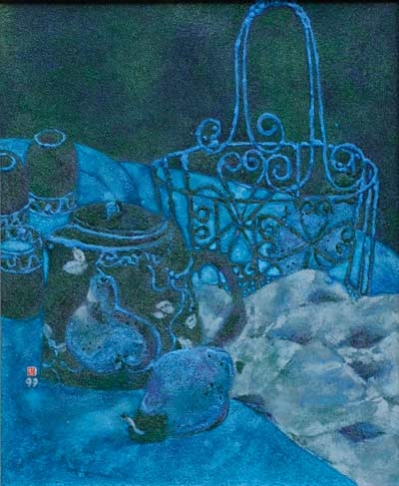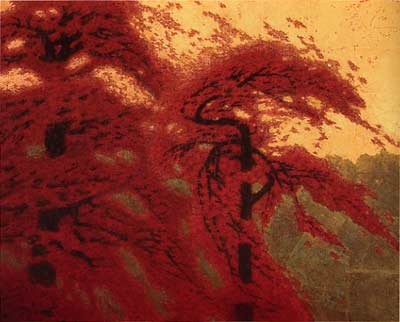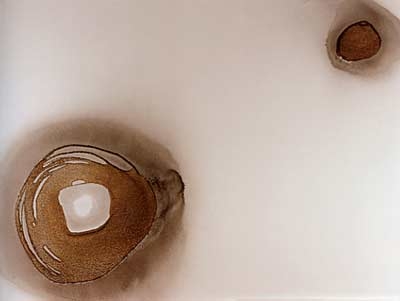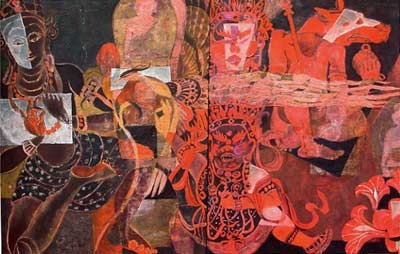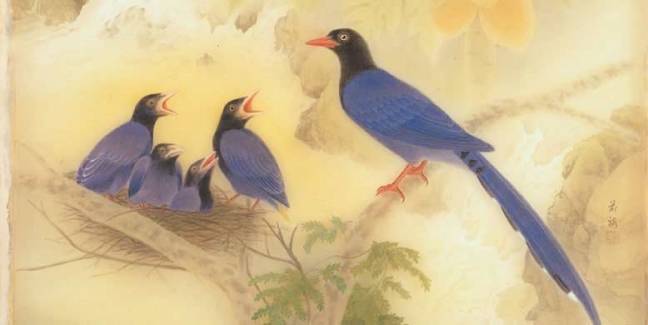Eastern Gouache, Heavy Color and Mineral Color Painting
2007.04.27~2007.05.27
09:00 - 17:00
Mineral pigment is a popular art medium since early Chinese art history. Until 1978, during the Reform and Openness period in Mainland China, heavy color paintings became a new art trend, and consequently the new term
Mineral Painting” appeared. On the other hand, Taiwan has inherited the
Toyoga” (Eastern Painting) tradition from Japanese Colonial Period, and the movement of
Eastern Couache” was rose in 1977. This movement also caused an open discussion in art field, which the mainstream then was Chinese ink painting. In terms of definition,
Mineral Color Painting” in China focuses on the multiple presentation of mineral pigments, while
Eastern Gouache” in Taiwan refers to paintings that use colors mixed with gelatin, clay or metal. Eastern Gouache is much more colorful and diverse than Mineral Color Painting. Nevertheless, in the future development of paintings in Taiwan and China, both Mineral Color and Eastern Gouache are, no doubt, experimental and modern media. In order to strengthen the public’s cognition on Mineral Color and Easter Gouache paintings, Professor (Curator) CHAN Chien-yu invites ten artists from Taiwan and China who are talented and innovative to participate this exhibition, including CHANG Hsiao-Lu, HU Wei, HU Ming-Che, LIN Guo-Chiang, CHANG Shuang, CHEN Yin-Wen, CHAN Chien-Yu, LEE Chen-Hui, KAO Yung-Long, and LIU Ling-Li. Their recent works could be a contrast of Chinese Mineral Color Painting and Taiwanese Eastern Gouache. From their works, the museum visitors could compare the differences of culture, arts, and education between China and Taiwan, and explore the future development of Mineral Color Painting and Eastern Gouache.
Mineral Painting” appeared. On the other hand, Taiwan has inherited the
Toyoga” (Eastern Painting) tradition from Japanese Colonial Period, and the movement of
Eastern Couache” was rose in 1977. This movement also caused an open discussion in art field, which the mainstream then was Chinese ink painting. In terms of definition,
Mineral Color Painting” in China focuses on the multiple presentation of mineral pigments, while
Eastern Gouache” in Taiwan refers to paintings that use colors mixed with gelatin, clay or metal. Eastern Gouache is much more colorful and diverse than Mineral Color Painting. Nevertheless, in the future development of paintings in Taiwan and China, both Mineral Color and Eastern Gouache are, no doubt, experimental and modern media. In order to strengthen the public’s cognition on Mineral Color and Easter Gouache paintings, Professor (Curator) CHAN Chien-yu invites ten artists from Taiwan and China who are talented and innovative to participate this exhibition, including CHANG Hsiao-Lu, HU Wei, HU Ming-Che, LIN Guo-Chiang, CHANG Shuang, CHEN Yin-Wen, CHAN Chien-Yu, LEE Chen-Hui, KAO Yung-Long, and LIU Ling-Li. Their recent works could be a contrast of Chinese Mineral Color Painting and Taiwanese Eastern Gouache. From their works, the museum visitors could compare the differences of culture, arts, and education between China and Taiwan, and explore the future development of Mineral Color Painting and Eastern Gouache.
Mineral pigment is a popular art medium since early Chinese art history. Until 1978, during the Reform and Openness period in Mainland China, heavy color paintings became a new art trend, and consequently the new term
Mineral Painting” appeared. On the other hand, Taiwan has inherited the
Toyoga” (Eastern Painting) tradition from Japanese Colonial Period, and the movement of
Eastern Couache” was rose in 1977. This movement also caused an open discussion in art field, which the mainstream then was Chinese ink painting. In terms of definition,
Mineral Color Painting” in China focuses on the multiple presentation of mineral pigments, while
Eastern Gouache” in Taiwan refers to paintings that use colors mixed with gelatin, clay or metal. Eastern Gouache is much more colorful and diverse than Mineral Color Painting. Nevertheless, in the future development of paintings in Taiwan and China, both Mineral Color and Eastern Gouache are, no doubt, experimental and modern media. In order to strengthen the public’s cognition on Mineral Color and Easter Gouache paintings, Professor (Curator) CHAN Chien-yu invites ten artists from Taiwan and China who are talented and innovative to participate this exhibition, including CHANG Hsiao-Lu, HU Wei, HU Ming-Che, LIN Guo-Chiang, CHANG Shuang, CHEN Yin-Wen, CHAN Chien-Yu, LEE Chen-Hui, KAO Yung-Long, and LIU Ling-Li. Their recent works could be a contrast of Chinese Mineral Color Painting and Taiwanese Eastern Gouache. From their works, the museum visitors could compare the differences of culture, arts, and education between China and Taiwan, and explore the future development of Mineral Color Painting and Eastern Gouache.
Mineral Painting” appeared. On the other hand, Taiwan has inherited the
Toyoga” (Eastern Painting) tradition from Japanese Colonial Period, and the movement of
Eastern Couache” was rose in 1977. This movement also caused an open discussion in art field, which the mainstream then was Chinese ink painting. In terms of definition,
Mineral Color Painting” in China focuses on the multiple presentation of mineral pigments, while
Eastern Gouache” in Taiwan refers to paintings that use colors mixed with gelatin, clay or metal. Eastern Gouache is much more colorful and diverse than Mineral Color Painting. Nevertheless, in the future development of paintings in Taiwan and China, both Mineral Color and Eastern Gouache are, no doubt, experimental and modern media. In order to strengthen the public’s cognition on Mineral Color and Easter Gouache paintings, Professor (Curator) CHAN Chien-yu invites ten artists from Taiwan and China who are talented and innovative to participate this exhibition, including CHANG Hsiao-Lu, HU Wei, HU Ming-Che, LIN Guo-Chiang, CHANG Shuang, CHEN Yin-Wen, CHAN Chien-Yu, LEE Chen-Hui, KAO Yung-Long, and LIU Ling-Li. Their recent works could be a contrast of Chinese Mineral Color Painting and Taiwanese Eastern Gouache. From their works, the museum visitors could compare the differences of culture, arts, and education between China and Taiwan, and explore the future development of Mineral Color Painting and Eastern Gouache.
KAO Yung-Lung is deeply attracted by Eastern Buddhistic culture. He learns from eastern and western traditional arts, and tries to present eastern gouache with modern spirits.
KAO Yung-Lung is deeply attracted by Eastern Buddhistic culture. He learns from eastern and western traditional arts, and tries to present eastern gouache with modern spirits.
Winds, clouds, trees and rocks are LEE Chen-Hui’s favorites. She presents a space of illusion and reality by observing life’s traces and Nature’s imagery.
Winds, clouds, trees and rocks are LEE Chen-Hui’s favorites. She presents a space of illusion and reality by observing life’s traces and Nature’s imagery.
CHAN Chien-Yu dedicated to promotion and education of eastern gouache in recent years. He is good at applying thin layers of color on silk, and creates a misty, dreamy and charming atmosphere.
CHAN Chien-Yu dedicated to promotion and education of eastern gouache in recent years. He is good at applying thin layers of color on silk, and creates a misty, dreamy and charming atmosphere.
CHEN Ying-Wen merges bright sunlight of Southern Taiwan and mysterious color of Buddhism into daily life scenes.
CHEN Ying-Wen merges bright sunlight of Southern Taiwan and mysterious color of Buddhism into daily life scenes.
CHANG Shuang lives in US in recent years. She likes to use abstract forms, simple structure, and symbolic signs to express the real facet of mental world.
CHANG Shuang lives in US in recent years. She likes to use abstract forms, simple structure, and symbolic signs to express the real facet of mental world.
LIN Guo-Chiang uses the technique of pointillism to construct a dim and dreamy world. He also presents the beautiful scene of Nature in different seasons by creating poetic and mysterious atmosphere.
LIN Guo-Chiang uses the technique of pointillism to construct a dim and dreamy world. He also presents the beautiful scene of Nature in different seasons by creating poetic and mysterious atmosphere.
HU Ming-Che is very sensitive. He likes to use rough mineral pigments to bring out the beauty and vigorous glamour of mineral color paintings. He is good at making different scenes and atmosphere in his still life paintings.
HU Ming-Che is very sensitive. He likes to use rough mineral pigments to bring out the beauty and vigorous glamour of mineral color paintings. He is good at making different scenes and atmosphere in his still life paintings.
After HU Wei graduated with Ph.D. degree from the Tokyo National University of Fine Arts & Music, his artistic style turned into more abstract. Inspired by the vigorous Chinese ancient bronze, he develops a technique of mixing foil and mixed media to create the texture. He also creates modern eastern abstract paintings with a macroscopic vision.
After HU Wei graduated with Ph.D. degree from the Tokyo National University of Fine Arts & Music, his artistic style turned into more abstract. Inspired by the vigorous Chinese ancient bronze, he develops a technique of mixing foil and mixed media to create the texture. He also creates modern eastern abstract paintings with a macroscopic vision.
CHANG Hsiao-Lu’s works present various subjects and styles. She absorbs the essence from Chinese ink and fine brushwork paintings, and apprehends the modern expression of classic fresco. She also tries to use techniques of thick paint and foil.
CHANG Hsiao-Lu’s works present various subjects and styles. She absorbs the essence from Chinese ink and fine brushwork paintings, and apprehends the modern expression of classic fresco. She also tries to use techniques of thick paint and foil.
LIU Ling-Li has the education background of studying prints in US. By absorbing the essence of traditional eastern aesthetics, her paintings feature simple and unsophisticated.
LIU Ling-Li has the education background of studying prints in US. By absorbing the essence of traditional eastern aesthetics, her paintings feature simple and unsophisticated.


